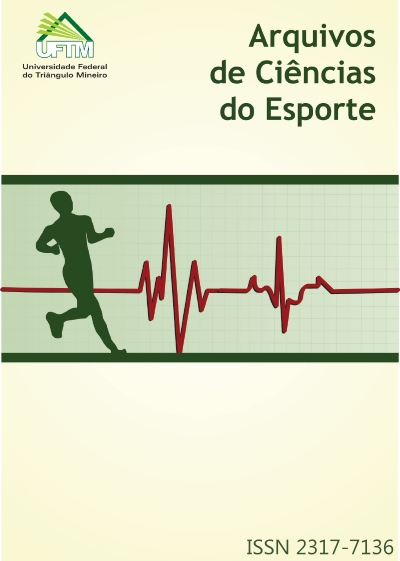Efeito de 12 semanas de treinamento aeróbio intradialítico no lipídico e hema-tológico em pacientes com doença renal crônica
Resumo
O objetivo do estudo foi avaliar o efeito de um programa de exercício aeróbios intradialíticos no perfil lipídico, hematológico, glicêmico e bioquímico em pacientes com doença renal crônicas (DRC). Participaram 15 pacientes (42,93 ± 12,94) que possuíam DRC. Foram incluídos apenas pacientes sem distúrbios ortopédicos ou neurológicos graves, doença cardiovascular instável, hipertensão não controlada, anemia grave, distúrbios eletrolíticos graves, incapacidade de entender instruções orais. Os pacientes foram submetidos a 12 semanas de intervenção com exercício aeróbio intradialítico. Os participantes foram instruídos a respeitar jejum de 12 horas, antes de cada coleta. Amostras de sangue foram colhidas antes e após intervenção, após 72h de abdicação de qualquer esforço físico. Para mensurar o perfil hematológico e os valores de glicose de jejum, colesterol total, HDL-c, LDL-c e triglicerídeos. Os parâmetros bioquímicos de rotina foram medidos de acordo com métodos padronizados. Foi observado redução significativa (-28,57%) na população de basófilos, um aumento significativo de colesterol total (+55,20%) e LDL (66,69%). Também houve um aumento significativo do potássio (96,45%). Contudo, 12 semanas de treinamento aeróbio intradialítico podem aumentar colesterol total, LDL e potássio assim como reduzir população de basófilos circulantes em pacientes com DCR.
Referências
Schlitt A, Jordan K, Vordermark D, Schwamborn J, Langer T, Thomssen C. Cardiotoxicity and Oncological Treatments. Dtsch Ärztebl Int. 2014 Mar;111(10):161–8.
Kalantar-Zadeh K, Balakrishnan VS. The kidney disease wasting: inflammation, oxidative stress, and diet-gene interaction. Hemodial Int Int Symp Home Hemodial. 2006 Oct;10(4):315–25.
Gowdak LHW, Paula FJ de, Giorgi DMA, Vieira MLC, Krieger EM, Lima JJGD. Cardiovascular disease and risk factors in candidates for renal transplantation. Arq Bras Cardiol. 2005 Feb;84(2):156–60.
Alencastro MG de, Lemos JRN, Bastos NMR de M, Vicari AR, Gonçalves LFS, Manfro RC. Evaluation of metabolic syndrome and associations with inflammation and graft function in renal transplant recipients. Braz J Nephrol J Bras Nefrol. 2013;35(4):299–307.
Neaton JD, Neuhaus J, Emery S. Soluble biomarkers and morbidity and mortality among people infected with HIV: summary of published reports from 1997 to 2010. Curr Opin HIV AIDS. 2010 Nov;5(6):480–90.
Luc G, Bard J-M, Juhan-Vague I, Ferrieres J, Evans A, Amouyel P, et al. C-reactive protein, interleukin-6, and fibrinogen as predictors of coronary heart disease: the PRIME Study. Arterioscler Thromb Vasc Biol. 2003 Jul 1;23(7):1255–61.
Qiu Z, Zheng K, Zhang H, Feng J, Wang L, Zhou H. Physical Exercise and Patients with Chronic Renal Failure: A Meta-Analysis. BioMed Res Int [Internet]. 2017 [cited 2018 Aug 30];2017. Available from: https://www.ncbi.nlm.nih.gov/pmc/articles/PMC5337868/
Zanetti HR, da Cruz LG, Lourenço CL, Ribeiro GC, Leite MAF de J, Neves FF, et al. Nonlinear Resistance Training Enhances the Lipid Profile and Reduces Inflammation Marker in People Living With HIV: A Randomized Clinical Trial. J Phys Act Health. 2016 Jul;13(7):765–70.
de Jesus Leite MAF, Puga GM, Arantes FJ, Oliveira CJF, Cunha LM, Bortolini MJS, et al. Effects of combined and resistance training on the inflammatory profile in breast cancer survivors: A systematic review. Complement Ther Med. 2018 Feb 1;36:73–81.
Ost M, Coleman V, Kasch J, Klaus S. Regulation of myokine expression: Role of exercise and cellular stress. Free Radic Biol Med. 2016 Sep;98:78–89.
Crews DC, Bello AK, Saadi G, Crews DC, Bello AK, Saadi G. Editorial do Dia Mundial do Rim 2019 - impacto, acesso e disparidades na doença renal. Braz J Nephrol. 2019 Mar;41(1):1–9.
SBN. Censo da Sociedade Brasileira de Nefrologia [Internet]. Sociedade Brasileira de Nefrologia. 2018 [cited 2018 Aug 30]. Available from: https://sbn.org.br/categoria/censo-2018/
Thomé FS, Sesso RC, Lopes AA, Lugon JR, Martins CT, Thomé FS, et al. Inquérito Brasileiro de Diálise Crônica 2017. Braz J Nephrol. 2019 Jun;41(2):208–14.
Lancaster GI, Febbraio MA. The immunomodulating role of exercise in metabolic disease. Trends Immunol. 2014 Jun;35(6):262–9.
Kalantar-Zadeh K, Block G, Humphreys MH, Kopple JD. Reverse epidemiology of cardiovascular risk factors in maintenance dialysis patients. Kidney Int. 2003 Mar;63(3):793–808.
Degoulet P, Legrain M, Réach I, Aimé F, Devriés C, Rojas P, et al. Mortality risk factors in patients treated by chronic hemodialysis. Report of the Diaphane collaborative study. Nephron. 1982;31(2):103–10.
Fleischmann EH, Bower JD, Salahudeen AK. Risk factor paradox in hemodialysis: better nutrition as a partial explanation. ASAIO J Am Soc Artif Intern Organs 1992. 2001 Feb;47(1):74–81.
Chmielewski M, Carrero JJ, Nordfors L, Lindholm B, Stenvinkel P. Lipid disorders in chronic kidney disease: reverse epidemiology and therapeutic approach. J Nephrol. 2008 Oct;21(5):635–44.
Orcy R, Antunes MF, Schiller T, Seus T, Böhlke M. Aerobic exercise increases phosphate removal during hemodialysis: a controlled trial. Hemodial Int Int Symp Home Hemodial. 2014 Apr;18(2):450–8.
Evans N, Forsyth E. End-stage renal disease in people with type 2 diabetes: systemic manifestations and exercise implications. Phys Ther. 2004 May;84(5):454–63.
Downloads
Publicado
Edição
Seção
Licença
Deverá ser encaminhado, no momento da submissão, em documentos suplementares, as declarações de transferência de direitos autorais, responsabilidade e conflito de interesse. As declarações deverão ser elaboradas em documento único, conforme modelo disponibilizado aqui, e assinada pelo autor principal do manuscrito representando cada um dos autores.


